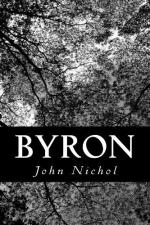I only loved: I only drew
The accursed breath of dungeon dew,—
the bird’s song breaking on the night of his solitude; his growing enamoured of despair, and regaining his freedom with a sigh, are all strokes from a master hand. From the same place, at the same date, he announces to Murray the completion of the third canto of Childe Harold. The productiveness of July is portentous. During that month he wrote the Monody on Sheridan, The Dream, Churchill’s Grave, the Sonnet to Lake Leman, Could I remount the River of my Years, part of Manfred, Prometheus, the Stanzas to Augusta, beginning,
My sister! My sweet sister!
If a name
Dearer and purer were, it should be thine;
and the terrible dream of Darkness, which at least in the ghastly power of the close, where the survivors meet by the lurid light of a dim altar fire, and die of each other’s hideousness, surpasses Campbell’s Last Man[1]. At Lausanne the poet made a pilgrimage to the haunts of Gibbon, broke a sprig from his acacia-tree, and carried off some rose leaves from his garden. Though entertaining friends, among them Mr. M.G. Lewis and Scrope Davies, he systematically shunned “the locust swarm of English tourists,” remarking on their obtrusive platitudes; as when he heard one of them at Chamouni inquire, “Did you ever see anything more truly rural?” Ultimately he got tired of the Calvinistic Genevese—one of whom is said to have swooned as he entered the room—and early in October set out with Hobhouse for Italy. They crossed the Simplon, and proceeded by the Lago Maggiore to Milan, admiring the pass, but slighting the somewhat hothouse beauties of the Borromean Islands. From Milan he writes, pronouncing its cathedral to be only a little inferior to that of Seville, and delighted with “a correspondence, all original and amatory, between Lucretia Borgia and Cardinal Bembo.” He secured a lock of the golden hair of the Pope’s daughter, and wished himself a cardinal.
[Footnote 1: This only
appeared in 1831, but Campbell claims to have
given Byron in conversation
the suggestion of the subject.]
At Verona, Byron dilates on the amphitheatre, as surpassing anything he had seen even in Greece, and on the faith of the people in the story of Juliet, from whose reputed tomb he sent some pieces of granite to Ada and his nieces. In November we find him settled in Venice, “the greenest isle of his imagination.” There he began to form those questionable alliances which are so marked a feature of his life, and so frequent a theme in his letters, that it is impossible to pass them without notice. The first of his temporary idols was Mariana Segati, “the wife of a merchant of Venice,” for some time his landlord. With this woman, whom he describes as an antelope with oriental eyes, wavy hair, voice like the cooing of a dove, and the spirit of a Bacchante, he remained




